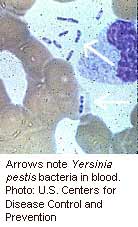
THURSDAY, Sept. 6 (HealthDay News) — When Sierra Jane Downing’s fever shot up to 107 degrees and she suffered a seizure, her parents knew their 7-year-old daughter had more than the flu.
Thanks to a persistent doctor, the little girl is recovering in a Denver hospital from a case of bubonic plague, the first identified in Colorado in more than six years. It’s thought she was bitten by infected insects — probably fleas — while trying to bury a dead squirrel on a family camping trip.
Hers is the fourth case of plague reported in the United States this year, the U.S. Centers for Disease Control and Prevention (CDC) said. “Over the last 10 years we have had an average of five cases a year,” said CDC epidemiologist Kiersten Kugeler. “So this year is quite average.”
However, plague — the scourge of the Middle Ages — is rare, so “people should not be panicky,” she said.
Kugeler said many more cases occurred in the early 1980s, when some years saw 30 to 40 people with plague. The reduction in infections is most likely the result of better sanitation and climate, she said.
Of this year’s infections, an Oregon man was the most severely affected and needed to have some fingers amputated, Kugeler said. He came down with plague after a bite from a family cat. It’s suspected that a woman who had contact with the same cat also developed plague but that case has not been confirmed. The fourth plague patient was an elderly man in New Mexico.
Most people recover with antibiotic therapy, but early treatment is important, experts say. “The last plague fatality in the United States was in 2009, because it was not recognized early enough,” Kugeler said.
Fleas infected with the bacterium Yersinia pestis are the usual source of plague, but infected animals, including rabbits, rodents and pets, can also transmit the disease.
The biggest barrier to treatment is that many doctors don’t recognize the symptoms — which include swollen lymph nodes — as those of plague. In addition to a tender, swollen lymph node in her groin, Downing also had low blood pressure and a high heart rate, according to published reports.
The dimpled girl, hospitalized in late August, is expected to make a full recovery, but had it not been for a tenacious emergency room doctor near her home in Pagosa Springs, her story might not have had a happy ending. That doctor reportedly called several hospitals until he found one — Rocky Mountain Hospital for Children — that wanted to see her immediately. She was air-lifted to their facility.
Plague can occur anywhere in the western United States, Kugeler said. “Since plague was introduced to this country in 1900, it has not passed what we call the plague line,” she noted. This longitudinal line roughly falls along the 100th meridian, which stretches north from Texas to North Dakota.
This probably has to do with environment, altitude, humidity and temperature — the conditions necessary for these types of fleas to survive, she said.
The best way to guard against plague and other diseases transmitted by infected rodents is to remove places around the yard where rodents like to live, such as wood piles, Kugeler said.
Protecting pets from fleas and ticks is also essential, she pointed out.
Plague almost never spreads from person to person. The only time person-to-person transmission is possible is when the bacteria reaches the lungs, she said. Then the plague can spread to those in close contact with the patient for an extended time, and then only just before they die.
“The last case of person-to-person in this country was in the 1920s,” Kugeler said.
In 14th-century Europe, the Black Death, as the plague was called, wiped out an estimated 35 percent of the population.
Nothing like that can happen here, experts say.
“Plague will never make a resurgence,” said Dr. Marc Siegel, an associate professor of medicine at NYU Langone Medical Center in New York City. “We have public health measures in place that prevent that.”
Treatment with antibiotics is effective, Siegel said. There is a need, however, for doctors to “think outside the box and recognize the possibility of plague,” he said.
More information
For more information on plague, visit the U.S. National Library of Medicine.

